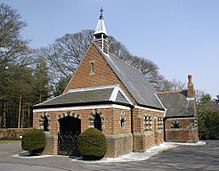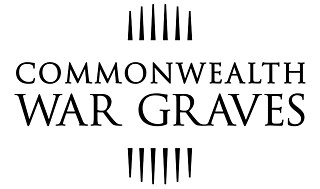
The Commonwealth War Graves Commission (CWGC) is an intergovernmental organisation of six independent member states whose principal function is to mark, record and maintain the graves and places of commemoration of Commonwealth of Nations military service members who died in the two World Wars. The commission is also responsible for commemorating Commonwealth civilians who died as a result of enemy action during the Second World War. The commission was founded by Sir Fabian Ware and constituted through Royal Charter in 1917 as the Imperial War Graves Commission. The change to the present name took place in 1960.

St Mary's Catholic Cemetery is located on Harrow Road, Kensal Green in London, England. It has its own Catholic chapel.

Stanley Military Cemetery is a cemetery located near St. Stephen's Beach in Stanley, Hong Kong. Along with the larger Hong Kong Cemetery, it is one of two military cemeteries of the early colonial era, used for the burials of the members of the garrison and their families between 1841 and 1866. There were no further burials here until World War II (1939–1945).

The Taiping War Cemetery is the final resting place for Allied personnel who were killed during World War II, particularly the Malayan Campaign and the Japanese occupation of Malaya following the British occupation and colonization of Malaya. Servicemen who died after the war or during their posting in northern Malaya prior to the Malayan Emergency are also interred here. The cemetery is located in Bukit Larut, Taiping, Perak, Malaysia and was erected and maintained by the Commonwealth War Graves Commission.
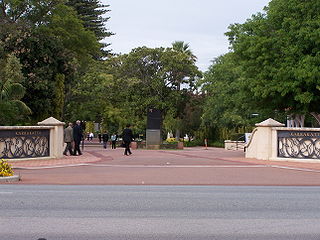
Karrakatta Cemetery is a metropolitan cemetery in the suburb of Karrakatta in Perth, Western Australia. Karrakatta Cemetery first opened for burials in 1899, the first being that of wheelwright Robert Creighton. Managed by the Metropolitan Cemeteries Board, the cemetery attracts more than one million visitors each year. Cypress trees located near the main entrance are a hallmark of Karrakatta Cemetery. The cemetery contains a crematorium, and in 1995 Western Australia's first mausoleum opened at the site.

Sai Wan War Cemetery is a military cemetery located in Chai Wan, Hong Kong which was built in 1946. The cemetery was created to commemorate soldiers of Hong Kong Garrison who perished during the Second World War. The cemetery also contains 12 World War I burials. A total of 1,528 soldiers, mainly from the Commonwealth, are commemorated here. Most of the remaining burials are located at the Stanley Military Cemetery.

Larch Wood Cemetery is a Commonwealth War Graves Commission (CWGC) burial ground for the dead of the First World War located in the Ypres Salient on the Western Front in Belgium.

Étaples Military Cemetery is a Commonwealth War Graves Commission cemetery in Étaples, near Boulogne on the north-west coast of France. The cemetery holds over 11,500 dead from both World War I and World War II.

Zillebeke Churchyard Commonwealth War Graves Commission Cemetery forms part of the village churchyard located around the Catholic parish church of Zillebeke in Belgium.

The National Field of Honour is a military cemetery for Canadian and Allied Veterans and their loved ones. It is located in Pointe-Claire, Quebec, Canada. It is operated by the Last Post Fund.

Fromelles Military Cemetery is a First World War cemetery built by the Commonwealth War Graves Commission on the outskirts of Fromelles in northern France, near the Belgian border. Constructed between 2009 and 2010, it was the first new Commonwealth War Graves Commission cemetery for more than 50 years, the last such cemeteries having been built after the Second World War. The cemetery contains the graves of 250 British and Australian soldiers who died on 19 July 1916 in the Battle of Fromelles.

Founded in 1917, the Ramscappelle Road Military Cemetery is located two kilometers east of the city of Nieuwpoort in the province of West Flanders (West-Vlaanderen), Belgium. It is on the N367, the road which leads from Nieuwpoort to the village of Sint-Joris, near the intersection with Ramscappelle Road (Ramskapellestraat).

The Arras Flying Services Memorial Commonwealth War Graves Commission war memorial in the Faubourg d'Amiens Cemetery, Arras, France. The memorial commemorates nearly 1,000 airmen from forces of the Commonwealth who were killed on the Western Front during World War I and who have no known grave. The memorial was designed by Edwin Lutyens, sculpted by William Reid Dick and unveiled by Hugh Trenchard, 1st Viscount Trenchard, Marshal of the Royal Air Force on 31 July 1932.

Lijssenthoek Military Cemetery is a Commonwealth War Graves Commission (CWGC) burial ground for the dead of the First World War in the Ypres Salient on the Western Front. After Tyne Cot, it is the second largest cemetery for Commonwealth forces in Belgium. Lijssenthoek Military Cemetery is located near Poperinge in the province of West Flanders. Most of those buried in the cemetery are war casualties who had been wounded near Ypres and later died in the four large Allied casualty clearing stations located in this area.
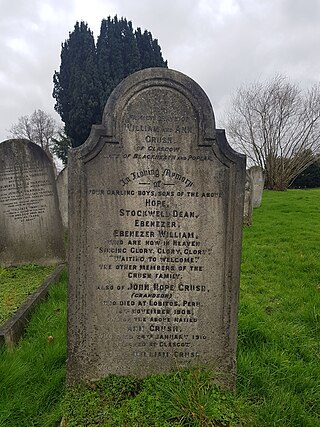
Greenwich Cemetery is a cemetery in the Royal Borough of Greenwich in southeast London. It is situated on the southwestern slopes of Shooter's Hill, on the western side of the A205 South Circular, Well Hall Road, approximately halfway between Woolwich, to the north, and Eltham, to the south.

Atherton War Cemetery is a heritage-listed cemetery at the corner of Kennedy Highway and Rockley Road, Atherton, Tablelands Region, Queensland, Australia. It was built in 1942. It was added to the Queensland Heritage Register on 19 November 2010.

Mont-Huon Military Cemetery is a Commonwealth War Graves Commission cemetery close to Le Tréport, north-west of Dieppe on the north-west coast of France. The cemetery holds over 2,300 dead from both World War I and World War II.
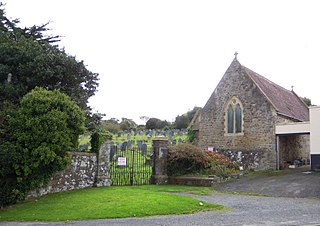
East-the-Water Cemetery was the Church of England burial ground for East-the-Water, once a separate village but now a suburb of Bideford, in Devon, England. Located on Barnstaple Road, the cemetery as of 2018 is abandoned and neglected, and the Victorian cemetery chapel is a dangerous structure on the verge of collapse. Burials in Bideford now take place at Bideford Higher Cemetery.
The Baghdad War Cemetery is a cemetery in Baghdad in Iraq. The cemetery contains 4480 interments and commemorations. Many graves are marked by Commonwealth War Graves Commission (CWGC) gravestones. The CWGC graves in the cemetery commemorate military personnel killed in the country in World War I and World War II. In 2012 511 CWGC headstones were repaired with new concrete bases and a new boundary fence was completed.

Bournemouth North Cemetery and Bournemouth Crematorium is a municipal cemetery in Bournemouth, England. The cemetery is located between the suburbs of Charminster, Strouden Park and Queen's Park and is owned by Bournemouth, Christchurch and Poole Council.
